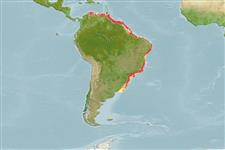Elasmobranchii (hajar och rockor) (sharks and rays) >
Carcharhiniformes (Ground sharks) >
Carcharhinidae (Requiem sharks)
Etymology: Rhizoprionodon: rhiza (Gr.), root; prion (Gr.) saw; odon (Gr.), tooth, referring to teeth with serrated (saw-like) bases, or roots [replacement name for Rhizoprion Ogilby 1915, preoccupied by Rhizoprion Jourdan 1861 in mammals] (See ETYFish); lalandii: In honor of naturalist and explorer Pierre Antoine Delalande (1787-1823), who collected type [authorship often attributed to Müller & Henle, who published Valenciennes’ description] (See ETYFish).
Eponymy: Pierre Antoine Delalande (1787–1823) was a French naturalist and explorer who worked for Muséum National d’Histoire Naturelle, Paris. [...] (Ref. 128868), visit book page.
Environment: milieu / climate zone / depth range / distribution range
Ekologi
marina bottenlevande; djupintervall 3 - 70 m (Ref. 244). Tropical; 13°N - 35°S, 78°W - 31°W
Western Atlantic: Panama to southern Brazil and Uruguay (Ref. 58839).
Length at first maturity / Size / Vikt / Age
Maturity: Lm 61.8, range 58 - ? cm
Max length : 80.0 cm TL (female); common length : 55.0 cm TL hane/ej könsbestämd; (Ref. 5217); publicerad maxvikt: 0.00 g
Inhabits shallow coastal waters, on sandy and muddy bottoms, and not normally found in lagoons and estuaries (Ref. 244). Feeds on small bony fishes, including sardines and anchovies, also shrimp and squid (Ref. 244). Viviparous, with 1 to 4 young in a litter; size at birth 33 to 34 cm (Ref. 244). Its flesh is highly appreciated and is marketed dried salted.
Distinct pairing with embrace (Ref. 205). Viviparous, placental (Ref. 50449).
Compagno, L.J.V., 1999. Checklist of living elasmobranchs. p. 471-498. In W.C. Hamlett (ed.) Sharks, skates, and rays: the biology of elasmobranch fishes. Johns Hopkins University Press, Maryland. (Ref. 35766)
IUCN Red List Status (Ref. 130435: Version 2024-1)
Threat to humans
Harmless
Human uses
Fiskeri: kommersiell
Verktyg
Special reports
Download XML
Internet-källor
Estimates based on models
Preferred temperature (Ref.
123201): 24.6 - 28, mean 27.2 °C (based on 104 cells).
Phylogenetic diversity index (Ref.
82804): PD
50 = 0.5078 [Uniqueness, from 0.5 = low to 2.0 = high].
Bayesian length-weight: a=0.00275 (0.00181 - 0.00418), b=3.07 (2.95 - 3.19), in cm total length, based on LWR estimates for this species & Genus-body shape (Ref.
93245).
Trofisk nivå (Ref.
69278): 4.3 ±0.65 se; based on food items.
Resiliens (Ref.
120179): Mycket låg, lägsta populationsfördubblingstid mer än 14 år (Fec=1).
Fishing Vulnerability (Ref.
59153): Moderate to high vulnerability (52 of 100).
